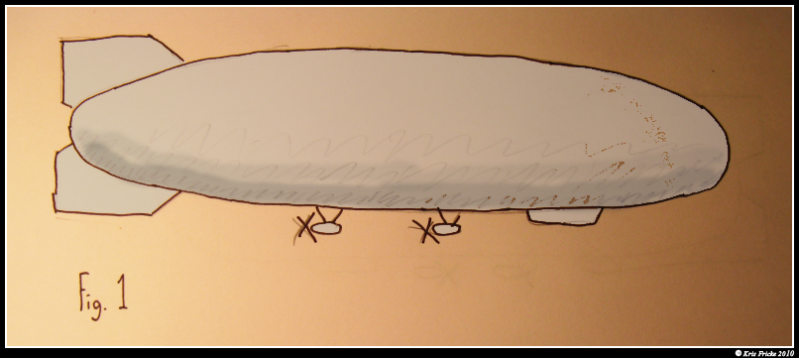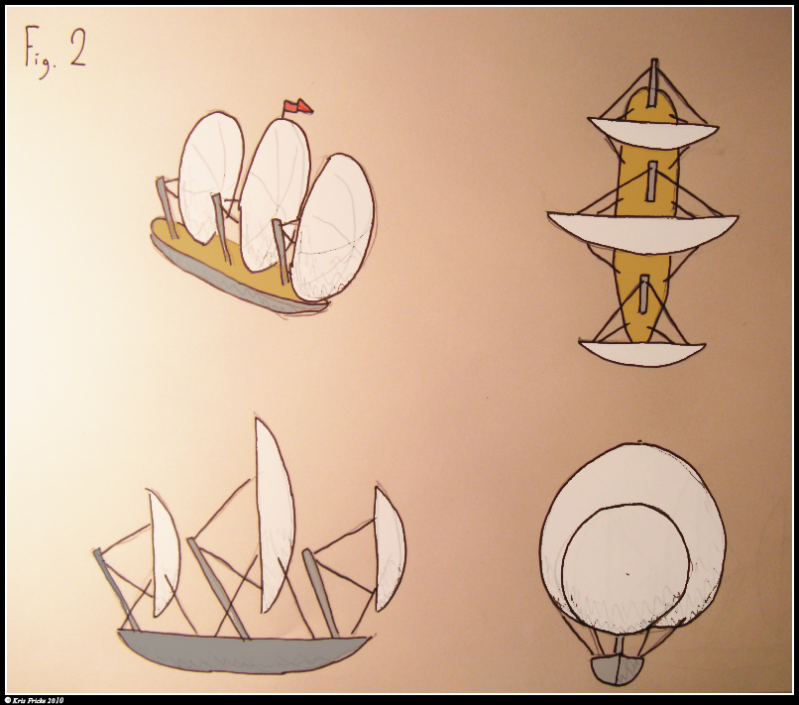A Rather Buoyant Scheme
Once upon a time last october I was standing in the sand in the middle of the Red Sea. I looked up and saw the wobbly distorted silhouettes of boats some 100 feet above me. A moray eel glided between some rocks nearby. The dive instructor made a signal and I pressed a button on my scuba suit. The inflatable vest filled with air until I released the button, and with my increased volume-weight ratio I floated gently off the sea floor until I reached a new equilibrium a few feet higher, and swam off toward the instructor.
It was around this time that a thought struck me. Zeppelins float effortlessly through the air due to buoyancy, but require power to move about. Sailing vessels move about effortlessly due to the sails harnessing the wind power, but obviously are not buoyant enough to float about in the air. What if one could combine these two things?

Fig. 1 - A hastily drawn and coloured zeppelin
What if you took a zeppelin, as pictured above, and put sails on it, as pictured below:

As I floated buoyantly there in the crystal clear Red Sea reefs I began to expand on this idea. Why not conserve space and make the sails themselves on such a vessel also the bags of lighter-than-air gas?

No need to make the sails square, a lense-like slice of a circle would probably be more efficient. They would be concave on the back to provide the wind something to push against and convex on the forward side to increase volume.
Obviously the vessel in this picture has a much higher hull-airbag ratio than the zeppelin, one might have to tinker with even bigger sails and/or perhaps also putting bags of lighter-than-air gas within the hull (providing of course that the hull remain heavier than the sails so it doesn't reverse-capsize.
But then it further occurred to me that the reason sailing works is because, while the wind is pushing against the sails in whatever direction it happens to be blowing, the vessel can only move in one direction due to its keel (well two, but you aim not to be going backwards). So these vessels clearly need keels. See Fig 3 below:

And, as I probably completely spaced out from whatever the diving instructor was trying to pantomime to me, I contemplated further: I know that square rigged sails (ie those that are perpendicular to the vessel) are better for harnessing the power of the wind if it is relatively coming from behind, but you can't sail at a very good angle INTO the wind -- fore-aft sails, ie sails that are parallel to the length of the vessel, ie Those Triangular Ones, are much better at maneuvering at angles to the wind. Up in the wild blue yonder there will no doubt be no shortage of wind, so it would be more valuable to go with the greater maneuverability option. This, it turned out, opened up a whole new pandora's box of problems.
In Fig 4 you see a fore aft vessel with giant keel. This looks like it could be a simple ocean-going vessel but keep in mind these sails still must contain lighter-than-air gas. In this case they are shaped in three dimensions like giant ravioli or pillows, again with a concave and convex side. I'd imagine one could arrange it so that the pressure of the wind will push whichever side you are using for that into the concave side.
In Fig 5 you see my realization that we no longer need a mast to hold these sails up, since they are holding themselves up above the ship (or rather, holding the entire ship up ... though now with less than three masts by age of sail terminology it would no longer be a ship but a boat). Also I realize that now we can fix our airbag-hull ratio a bit since the sails can be wildly bigger than the hull.

But of course to sail with these sails you'd traditionally loosen the ropes leading to the aft end of each sail, allowing the wind to blow it into an angle where the wind is more fully hitting it. At the arrangement we have in Fig 5 loosening these lines would... just make the sail raise up higher above the vessel (or, again, actually it would just lower the vessel's hull). So that brings us to Figs 6 & 7, where we have placed sort of horizontal masts off abeam on both sides in order to run lines from them to the ends of the sails so the sails can be swung about without simply raising up and down.
While we're at it, just for fun, we decided to utilize the Kutta-Joukowski theorem in shaping these protrusions, what fun!
Also, why put the keel on the bottom where it will utterly flummox your attempts at landing when you may as well continue the inversion and run it upwards between the sails. This could also house some lighter-than-air gas-bags within itself.
And so, there you have it, my hare brained theory as to how one could make a totally steam-punk flying dirigible schooner. An idea wildly conceived 100 feet below the surface of the Red Sea, perhaps only attributable to suffering from abnormal levels of oxygen at the time!